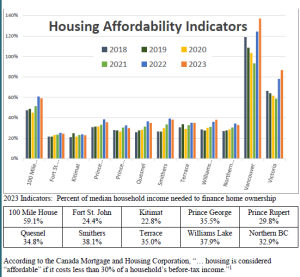
NORTHERN BC – The BC Northern Real Estate Board (BCNREB) Housing Affordability Indicators estimate the proportion of median household income required to cover the major costs associated with home ownership for homes purchased in a particular year.
These include mortgage costs, municipal taxes and fees, and utilities for the average single-family home. The higher the measure, the more difficult it is to afford a home. For example, an affordability measure of 30% means that home ownership costs, including mortgage payments, utilities, and property taxes for a given year take up 30% of a typical household’s pre-tax annual income.
Home ownership in northern British Columbia remains very affordable, especially when compared with the Vancouver or and Victoria regions. The aggregate Housing Affordability Indicator (HAI) for northern BC for 2023 remains greater than 30%, checking in at 32.9%, a slight decrease from the 2022 HAI. The affordability of home ownership in northern BC is exceptionally favourable when compared with the Vancouver Area, which experienced another year of significantly worsening affordability, clocking in at 137.0% for 2023.

According to the Canada Mortgage and Housing Corporation, “… housing is considered “affordable” if it costs less than 30% of a household’s before-tax income.”1
Notes:
Northern BC is comprised of the: Bulkley-Nechako, Cariboo, Fraser-Fort George, Kitimat-Stikine, North Coast and Peace River Regional Districts and the Northern Rockies Regional Municipality.
Measures of affordability for single-family detached homes for Vancouver area and Victoria are an average of the quarterly Housing Affordability Measure drawn from RBC Economic Research reports.
This edition of the Housing Affordability Indicators for northern British Columbia includes changes to the HAI for 2020 through 2022 arising from data revisions to Median Household Income for the year 2020 due to the availability of new data from the 2021 Census. In the case of Fort St. John, this change is noteworthy. Median Household Income in that community did not increase as predicted by Average Weekly Earnings numbers for the period and so has seen a significant correction for 2020.
Affordability by Community
Affordability improved in 2023 for nearly all measured northern BC communities. Only Williams Lake saw affordability worsen, while the HAI for Terrace remained unchanged. In terms of home ownership, 100 Mile House remains the least affordable community in northern BC. The major factor for this result continues to be median household income; 100 Mile House being markedly lower in that measure than other communities in Northern British Columbia.
Kitimat and Fort St. John continued to be the most affordable communities in Northern BC in 2023, as they have been for the previous five years.

Price stabilization
The average price for a detached single-family home in northern BC increased in only 4 measured communities in 2023, and only in Williams Lake did prices increase significantly (up 10.4% over 2022). Average house prices decreased in the other five measured communities, though in three of those the decreases were well under 1%. Prince George and Prince Rupert experienced noteworthy average house price decreases. The average price in northern BC in 2023 was $448,769, a 0.5% decrease over 2022 prices.
Average house prices in 2023 varied widely from community to community, topping out at $517,291 in Smithers, with Terrace and Prince George also surpassing the $500,000 threshold. Williams Lake saw the largest increase in prices, increasing more than 10% over 2022 to hit $477,948. Kitimat continues to enjoy the lowest average house price of $377,825.
Only Quesnel and Kitimat had average house prices below $400,000.
Source: BCNREB


